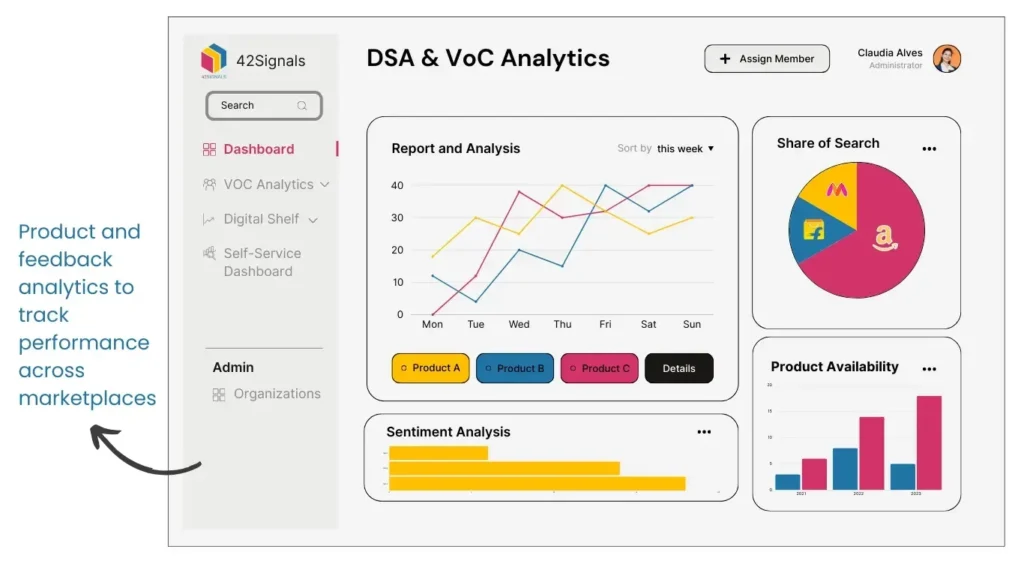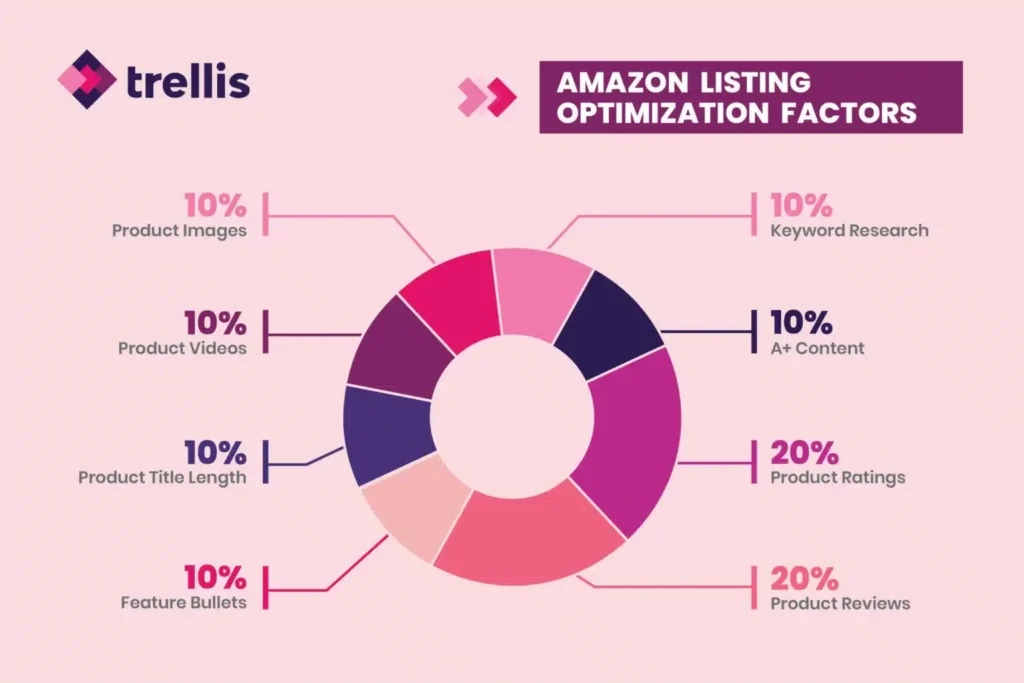In recent years, the adoption of eCommerce has accelerated, and COVID-19 has further fueled the shift toward digital shopping. Post-pandemic shoppers are now more inclined towards online purchases, making it crucial for online brands to establish a strong presence on the digital shelf with digital shelf analytics.
The digital shelf refers to how and where a brand’s products are displayed online. It encompasses various forms such as category pages, product recommendation lists, and search results.

With the increasing number of consumers shopping online, companies are now focused on increasing their visibility on the digital shelf as appearing toward the top of search results is essential to drive sales.
Search results play a significant role in determining a brand’s visibility online. Hence, e-commerce businesses need to prioritize their search engine optimization efforts to rank higher in search results.
Providing a great customer experience is another factor that’s vital for e-commerce businesses.. Sellers must focus on maintaining inventory and avoiding stockouts to ensure a seamless shopping experience for their customers.
While these are all important aspects, let’s look at how leading brands can prioritize their digital shelf by adopting digital shelf analytics.
Optimizing Product Listings with Digital Shelf Analytics

Image Source: Trellis
As mentioned, appearing at the top of search results is crucial to get your product sold and increase revenue. This can be achieved by –
1. Creating Honest and Accurate Product Descriptions
Providing shoppers with honest and accurate product descriptions is essential to help them make informed purchasing decisions. This requires including all relevant details, such as specifications, features, and benefits. When brands are transparent it builds trust with consumers and reduces the likelihood of returns or negative reviews.
2. Platform-Specific Optimization Strategies with Digital Shelf Analytics
Different platforms may require specific optimization strategies to maximize product visibility. Businesses should conduct thorough research and adapt their listings according to the requirements of the marketplace. This may involve using platform-specific keyword research tools, optimizing website content, and leveraging features like ‘Buy Now’ buttons and shoppable videos.
3. Adapting to Evolving Platforms and Search Results
The digital landscape is constantly evolving; platforms and search algorithms frequently change. Companies must continuously review and adjust their product listings to stay competitive and appealing to their audiences. This includes monitoring search trends, analyzing sales data, and making necessary optimizations to maintain visibility online.
Overcoming Challenges and Winning with Digital Shelf Analytics
As the e-commerce industry continues to evolve, online establishments need to stay a step ahead and adopt strategies that work for them. Easier said than done, there are still several challenges that businesses can face in this endeavor. To focus on this area of concern, the following obstacles must be addressed.
Improving Brand Representation and Supply Chain Strategy
Leading brands understand the importance of consistent brand representation and a unified supply chain strategy. Poor brand representation can lead to confusion among consumers and negatively impact sales. To mitigate this challenge, businesses should focus on creating a strong brand identity across all online platforms, ensuring that their logos, colors, and messaging are consistent.
Additionally, a unified supply chain strategy is crucial for businesses to meet the demands of online shoppers effectively. By streamlining their supply chain processes, they can ensure their products are readily available and delivered to customers in a timely manner. This includes optimizing inventory management, implementing efficient order fulfillment systems, and collaborating closely with suppliers and distributors.
Consistency in Brand Packaging and Taking Control with Digital Shelf Analytics
Another challenge that sellers face on the digital shelf is maintaining consistency in brand packaging. Inconsistent packaging can confuse customers and dilute brand recognition. Brands should establish clear guidelines for packaging design and ensure that their products are presented consistently across all online platforms. This includes using standardized product images, detailed product descriptions, and accurate dimensions and specifications.
Maximizing Visibility and Understanding Shopping Habits
None of the above strategies work if there’s no visibility. To ensure that products are seen by customers, optimizing product listings with relevant keywords, leveraging paid advertising campaigns, and utilizing search engine optimization techniques are a must. Businesses should also consider the importance of customer reviews and ratings, as positive feedback can significantly influence purchasing decisions.
Analyzing consumer behavior, such as browsing patterns, search queries, and purchase preferences, is required to tailor marketing strategies accordingly. By aligning offerings with customer needs and preferences, sellers can increase their chances of conversion and drive sales.
The Need for Advanced Technology in Digital Shelf

As brands vie for digital shelf dominance, the need for advanced technology becomes increasingly apparent. Next-generation digital shelf solutions play a pivotal role in helping businesses beat the competition and achieve real-time visibility of their products.
Digital shelf analytics provide e-commerce establishments with valuable data on sales, search trends, product information, promotions, pricing, and customer ratings and reviews. By leveraging this data, brands can gain insights into consumer behavior, optimize their strategies, and make informed decisions to improve their digital shelf performance.
42Signals – an e-commerce analytics platform – empowers today’s e-commerce businesses with reliable analytics. With our digital shelf analytics solution, businesses can track KPIs like share of search, product availability, pricing-related analytics, and reviews to amplify their online growth. Companies can also discover product trends to gain competitive insights, both at the category and brand levels across marketplaces.
Frequently Asked Questions
What are digital shelf analytics?
Digital shelf analytics is the process of tracking, measuring, and optimizing how products appear and perform across online retail platforms like Amazon, Walmart, or Target. It helps brands understand what shoppers see when they browse online, and how that affects buying decisions.
This includes monitoring:
- Product content (titles, images, descriptions)
- Search placement and visibility
- Pricing and promotions
- Stock availability
- Ratings and reviews
- Competitor performance
What are the 4 types of digital analytics?
The four main types of digital analytics provide different levels of insight depending on what a business wants to learn:
- Descriptive Analytics – Looks at what has happened based on historical data (e.g., monthly sales or product page visits).
- Diagnostic Analytics – Explains why something happened, helping to uncover causes behind performance drops or spikes.
- Predictive Analytics – Uses trends and historical patterns to forecast future outcomes, like expected sales or demand.
- Prescriptive Analytics – Recommends specific actions based on data (e.g., adjusting pricing to increase conversions).
Which of the following KPIs can be measured from a digital shelf?
A variety of Key Performance Indicators (KPIs) can be tracked using digital shelf analytics, including:
- Search Rank – Where your product appears in search results for key terms
- Buy Box Ownership – How often your listing wins the “Buy Now” spot on platforms like Amazon
- Stock Availability – Whether your product is in or out of stock
- Content Compliance – Whether titles, images, and descriptions match brand guidelines
- Pricing Consistency – How your price compares across platforms and versus competitors
- Customer Ratings & Reviews – Volume and sentiment of shopper feedback
What does digital shelf mean?
The digital shelf refers to the online environment where your product is displayed, discovered, and purchased by customers. It’s the digital version of a retail shelf — but instead of a physical store, it’s what shoppers see on eCommerce sites, apps, and search engines.
It includes:
- Product images and descriptions
- Search rankings
- Prices and discounts
- Ratings, reviews, and comparisons
- Placement on category or brand pages







